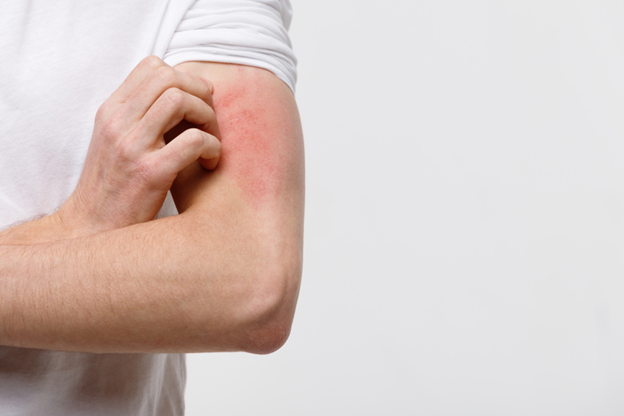What is Dermatitis?
Dermatitis is an umbrella term used to describe a group of conditions that cause inflammation, redness, and irritation of the skin. This skin condition can affect any part of the body, but it typically appears on the face, hands, feet, and arms. It is often characterized by itching, swelling, dryness, and in some cases, blisters or cracking of the skin.
There are different types of dermatitis, and understanding the specific type can help in determining the appropriate treatment plan. The four most common types of dermatitis are:
- Atopic Dermatitis (Eczema): This chronic condition typically begins in childhood and is often associated with other allergic conditions such as asthma or hay fever. It results from an overactive immune response that causes inflammation in the skin.
- Contact Dermatitis: Triggered by contact with irritants or allergens, this form of dermatitis results in localized inflammation and skin irritation.
- Seborrheic Dermatitis: Often affecting areas with a high concentration of sebaceous glands, like the scalp, face, and upper torso, seborrheic dermatitis causes greasy, flaky patches of skin, sometimes with redness and itching.
- Nummular Dermatitis: This type presents as round, coin-shaped patches of irritated skin that are typically itchy and dry.
Symptoms of Dermatitis
The symptoms of dermatitis vary depending on the type and severity of the condition, but common signs include:
- Red, inflamed skin: The skin becomes red and swollen, sometimes accompanied by a rash.
- Itching: The skin becomes intensely itchy, and scratching can worsen the condition.
- Dry or scaly skin: The skin can become dry, flaky, or leathery, especially if not treated.
- Blisters or oozing: Some forms of dermatitis, like allergic contact dermatitis, can cause the skin to blister or weep.
- Cracking or bleeding: In severe cases, the skin may crack open, leading to possible infection or further irritation.
Causes of Dermatitis
The causes of dermatitis depend on the specific type. However, in general, dermatitis is often triggered by a combination of genetic and environmental factors. Here are some common causes:
1. Genetics
A family history of eczema, asthma, or other allergic conditions increases the likelihood of developing atopic dermatitis (eczema). An individual with such a family history may be more prone to the condition because of inherited immune system tendencies.
2. Environmental Factors
Environmental triggers play a significant role in all forms of dermatitis. These can include:
- Allergens: Pollen, dust mites, pet dander, or mold can trigger an immune response that leads to dermatitis.
- Irritants: Harsh soaps, detergents, certain fabrics, and chemical substances in cosmetics or household cleaners may irritate the skin and lead to contact dermatitis.
- Weather: Cold or dry weather can exacerbate symptoms, especially in individuals with atopic dermatitis.
- Infections: Bacterial, fungal, or viral infections can trigger or worsen dermatitis. Skin lesions, for example, may become infected if scratched.
3. Immune System Responses
In many cases of dermatitis, especially atopic dermatitis, the immune system overreacts to harmless environmental triggers. This results in inflammation of the skin and the symptoms associated with the condition. In seborrheic dermatitis, an overgrowth of yeast can cause inflammation and skin irritation.
4. Stress
Stress is known to trigger flare-ups of eczema and other types of dermatitis. This is particularly true for individuals with a history of atopic dermatitis or those prone to skin conditions. Emotional stress can impact the body’s immune function and worsen inflammation.
5. Hormonal Changes
Hormonal fluctuations, especially those occurring during pregnancy, menstruation, or puberty, can contribute to the onset or worsening of dermatitis symptoms. For example, some women may experience an increase in eczema flare-ups during pregnancy.
Diagnosis of Dermatitis
Diagnosing dermatitis typically begins with a thorough physical examination. Your healthcare provider will ask about your medical history, lifestyle, and the possible triggers or allergens in your environment. In some cases, your doctor may recommend additional tests, such as:
- Patch Testing: To identify potential allergens or irritants that might be triggering contact dermatitis.
- Skin Biopsy: A small sample of skin may be taken to examine under a microscope to confirm the diagnosis and rule out other conditions.
- Blood Tests: Blood tests may be done to check for signs of an infection or to evaluate levels of specific antibodies that indicate an allergic reaction.
Treatment and Management of Dermatitis
Although dermatitis cannot be cured, there are various ways to manage and relieve the symptoms. The treatment plan will depend on the severity and type of dermatitis but may include:
1. Topical Steroids
Topical corticosteroids are commonly used to reduce inflammation and itching in cases of eczema and other inflammatory skin conditions. These medications should be used according to the doctor’s instructions, as overuse may lead to thinning of the skin or other side effects.
2. Moisturizers
Keeping the skin hydrated is crucial in managing dermatitis, particularly for dry and scaly skin. Using emollients and moisturizers regularly can prevent skin dryness and irritation. Thick creams and ointments are often preferred over lotions because they provide more intensive moisture.
3. Antihistamines
For individuals experiencing significant itching, antihistamines can be helpful in reducing symptoms. These can be taken orally and may be especially useful for nighttime itching.
4. Immunosuppressive Medications
For severe cases of dermatitis that do not respond to topical treatments, immunosuppressive medications may be prescribed. These help control the immune system’s response and reduce inflammation.
5. Phototherapy
Phototherapy, or light therapy, involves exposing the skin to ultraviolet (UV) light under controlled conditions. This treatment can be helpful in managing severe cases of eczema or psoriasis when topical treatments are ineffective.
6. Avoiding Triggers
Identifying and avoiding environmental triggers is essential for managing dermatitis. This can involve changes in lifestyle, such as using fragrance-free skincare products, wearing protective gloves, and avoiding known allergens.
Prevention Tips
While it may not be possible to prevent dermatitis entirely, you can reduce the frequency and severity of flare-ups by following these tips:
- Moisturize regularly: Use a thick, fragrance-free moisturizer daily, especially after bathing, to lock in moisture.
- Avoid harsh chemicals: Use mild, fragrance-free soaps, detergents, and skincare products to avoid irritating your skin.
- Wear soft fabrics: Choose clothing made from cotton or other breathable fabrics to reduce skin irritation.
- Manage stress: Stress can trigger flare-ups, so finding ways to relax and reduce stress, such as meditation or yoga, can be beneficial.
- Avoid known allergens: If you know specific triggers (such as pet dander or pollen), try to avoid them as much as possible.
Conclusion
Dermatitis is a common condition that can be distressing due to its impact on the skin and quality of life. By understanding the causes, symptoms, and treatment options available, individuals with dermatitis can take proactive steps to manage the condition effectively. Regular skincare, avoidance of triggers, and adherence to prescribed treatments can help maintain healthy skin and prevent flare-ups. If you suspect you have dermatitis, consult with a healthcare provider to develop an appropriate treatment plan tailored to your needs.
Consult us today at Doctor’s diagnostic for expert guidance!

